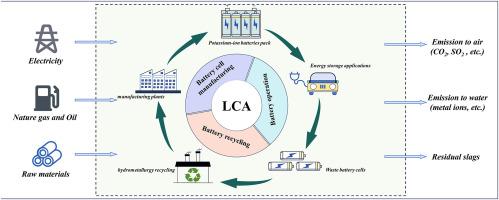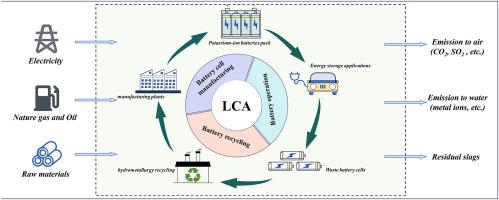Environmental impact analysis of potassium-ion batteries based on the life cycle assessment: A comparison with lithium iron phosphate batteries
IF 9.7
1区 环境科学与生态学
Q1 ENGINEERING, ENVIRONMENTAL
引用次数: 0
Abstract
Potassium-ion batteries are being considered as a potential alternative to lithium-ion batteries due to their environmental friendliness and lack of dependence on scarce materials. However, it is currently unknown how their environmental impacts compare to that of LiFePO4 batteries. This study establishes a comprehensive and transparent life cycle inventory of four different types of potassium-ion batteries and presents a prospective cradle-to-grave life cycle assessment of these batteries. Potassium-ion batteries are found to be promising from a comprehensive life cycle perspective, particularly for KFeSO4F batteries. In terms of battery manufacturing, the utilization of aluminum foil as an anode collector allows the human non-carcinogenic toxicity and mineral resource scarcity values of potassium-ion batteries (except for KVPO4F batteries) to be only 15% and 24% of those of LiFePO4 batteries. However, the relatively lower energy density of potassium-ion batteries results in a less favorable performance than LiFePO4 batteries in the global warming and fossil resource scarcity categories. Furthermore, the environmental impacts for potassium-ion batteries arising from electricity losses in the use phase account for a significant portion of the entire system, contributing on average 59%, 52% and 48% to the global warming, fossil resourcing scarcity, and terrestrial acidification categories, respectively. For both potassium-ion and LiFePO4 batteries, the recovery of certain materials makes the hydrometallurgical recycling process have a positive environmental effect. Sensitivity analyses highlight the pivotal role of enhanced energy density and cycle life in the prospective advancement of potassium-ion batteries. This work provides a theoretical basis for future potassium-ion battery research.


基于生命周期评估的钾离子电池环境影响分析:与磷酸铁锂电池的比较
钾离子电池因其环保和不依赖稀缺材料而被视为锂离子电池的潜在替代品。然而,目前还不清楚钾离子电池对环境的影响与磷酸铁锂电池相比如何。本研究为四种不同类型的钾离子电池建立了全面、透明的生命周期清单,并对这些电池进行了前瞻性的 "从摇篮到坟墓 "生命周期评估。研究发现,从综合生命周期的角度来看,钾离子电池,尤其是钾铁SO4F 电池很有发展前景。在电池制造方面,由于使用铝箔作为阳极集流体,钾离子电池(KVPO4F 电池除外)的人体非致癌毒性和矿物资源稀缺值仅为磷酸铁锂电池的 15%和 24%。然而,由于钾离子电池的能量密度相对较低,因此在全球变暖和化石资源稀缺方面的表现不如磷酸铁锂电池。此外,钾离子电池在使用阶段的电力损耗对环境的影响在整个系统中占很大比重,在全球变暖、化石资源稀缺和陆地酸化类别中的平均影响分别为 59%、52% 和 48%。对于钾离子电池和磷酸铁锂电池而言,某些材料的回收使得湿法冶金回收工艺对环境产生了积极影响。敏感性分析强调了提高能量密度和循环寿命在钾离子电池的发展前景中的关键作用。这项工作为未来的钾离子电池研究提供了理论基础。
本文章由计算机程序翻译,如有差异,请以英文原文为准。
求助全文
约1分钟内获得全文
求助全文
来源期刊

Journal of Cleaner Production
环境科学-工程:环境
CiteScore
20.40
自引率
9.00%
发文量
4720
审稿时长
111 days
期刊介绍:
The Journal of Cleaner Production is an international, transdisciplinary journal that addresses and discusses theoretical and practical Cleaner Production, Environmental, and Sustainability issues. It aims to help societies become more sustainable by focusing on the concept of 'Cleaner Production', which aims at preventing waste production and increasing efficiencies in energy, water, resources, and human capital use. The journal serves as a platform for corporations, governments, education institutions, regions, and societies to engage in discussions and research related to Cleaner Production, environmental, and sustainability practices.
 求助内容:
求助内容: 应助结果提醒方式:
应助结果提醒方式:


